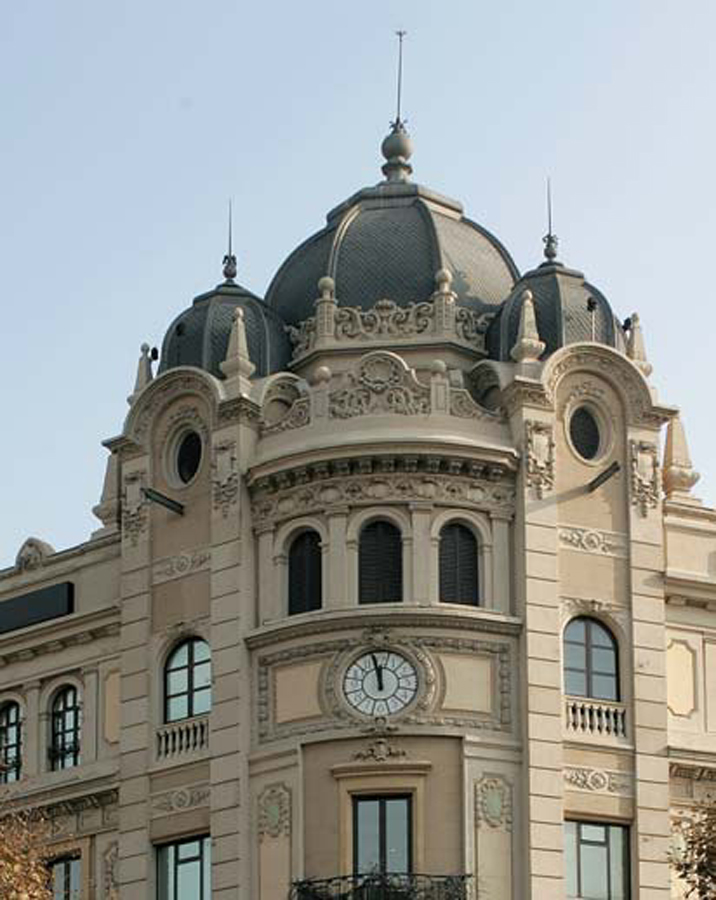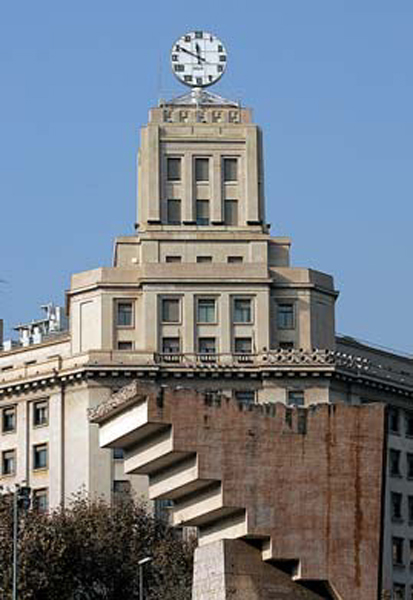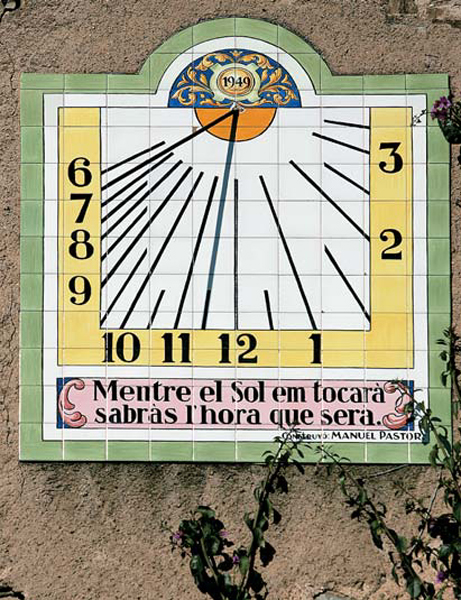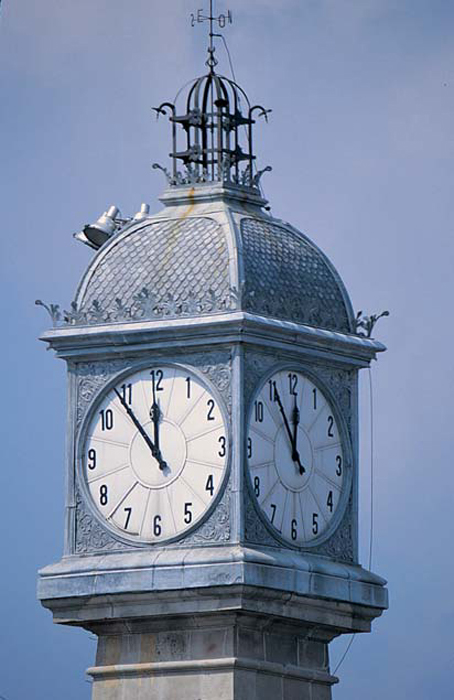|
Barcelona: Watch clocks
"Forgive, what's the time?" Occasionally there is someone who stops us on the street to ask us the time, but less and less ... And the few who do not have a watch have a few in sight, in Barcelona. We find sundials in some farmhouses that survive within the urban density, on the facade and crowning unique buildings, especially from the city center. Some of them have been for many years an important reference for the exact time walking. This was the case of the Real Academia de Ciencias y Artes, which is still active today, which gave official time to many people from Barcelona and even to the boats that docked in the harbor.
Until the twentieth century, the upper part of La Rambla, beneath Canaletes, was a place quite crowded by the locals. They put their hand in their pocket and stopped in front of the building of the Academy of Sciences and Arts, where there is also the Poliorama Theater. They took the watch out of their pocket and put their needles in the exact same position as the clock on the facade.
The Clock of the Academy of Sciences and Arts (La Rambla, 115) was founded in 1891 to correct "the hourly anarchy that reigned in the city." Since then the official time says. It also served ships that made their way to Barcelona: their chronometers brought them to the Academy, where they were deposited the days that were in port, in order to study them and rectify the time if necessary. The architect of the clock at the Academy was Carles Fontserè, meteorologist and seismologist. Until 1926, the Academy determined the time for astronomical observations from the domes of its building and, henceforth, for radio signals. Inside the Academy there is a room with other fantastic clocks. It is notable that made by the Swiss bank established in Barcelona Albert Billeter: it is an astronomical clock that marks the time, the exit and the sunset, and the time to twenty-four capitals of the world. In addition, it has a perpetual calendar and a planetarium with signs of the zodiac.
With the clock of the Academy of Sciences and Arts we have started our particular route for the clocks that are in sight in Barcelona, a significant number of which we find very close to it. If we follow the Rambla up to Plaça Catalunya, we will find three more: in the La Sfera building, which had been the headquarters of the Central Bank (Rambla / plaça de Catalunya); in the South America building,
which made the banker and politician Manuel Girona (round of Sant Pere / plaça de Catalunya) - this one, however, stopped - and the spheric that is turning at the top of the BBVA building (Bergara / Plaça de Catalunya) , the work of the architect Pedro Candoya, opened in 1952 (the clock, however, settled a few years later). The Banco Vizcaya Argentaria Bank is a large clock, although being so far upstairs does not look like it looks like the hours are two meters long and the whole set weighs almost two tons. Since it is only supported by the base and in the place where it is suffered by significant winds, a solid structure sustains it. One of the faces marks the hours with Roman numerals and the other shows the logo of the banking entity, which in the evening is lit.
On the Avenida del Portal de l'Àngel, 23 (street corner of Santa Anna), hanging from the façade, a watch with a diameter of a store of Central Switzerland has been installed since 1933 , dedicated to watches, jewelry and silver items. By his way, remember the clocks that were previously carried with a chain stuck in his pocket. A Swiss watch, of precision, could not be missed in the center of the city, but they say that now that it is electric is slightly ahead because of the current oscillations, whereas before, which was rope, it was very accurate. In Ciutat Vella itself, at the end of the Rambla, there is the old gunsmith basement, a 17th century building in which, in addition to guns, bells were made (such as, for example, Tomassa, the largest of the cathedral). It was also the headquarters of the Banc de Barcelona in 1858, the first in Spain, created by Manuel Girona, who was mayor of Barcelona and promoter of many projects in the city, such as the new port, the University and the Universal Exhibition (1888). On the main façade there was a clock, but the army, at the end of the Civil War, replaced it with a Francoist shield. In 1991, the City Council's Urban Landscape Institute restored the facade and restored the clock that had been installed on the occasion of the conversion of the building into a bank, after convincing the military of the need to remove the shield. The clock, sponsored by Seiko, continues to be seen in this building on the Rambla, numbers 2-4.
"MENTRE EL SOL ME TOCARÀ"
Some farmhouses survive in Barcelona, especially in the upper area (Horta and Las Cortes). There are no gardens in their surroundings or cattle and almost all have a different use of the original, most of them are now restaurants. In any case, some conserve one of their identitary signs, the sundials on the facade, always oriented towards the south. You need to know to read, of course; It is very simple but we must take into account the difference in solar time with which we work in winter or summer. There are beautiful sundials, for example, in the Barça farmhouse (Can Planas), from the 18th century, located right next to the Nou Camp (today it is the residence of young people from Barça, those outside Barcelona who stay at the city); There is also Can Calopa de Dalt, a 16th-century farmhouse on the road from Vallvidrera to Molins de Rei, kilometer 5; In the farmhouse of Can Cadena (street Menorca, 25), which was acquired by the City Council so that the neighborhood could use the orchard, whose façade has the vane door and a sun clock with the classic "Carpe Diem"; in Can Mariner, in Horta (in Calle Horta, 46, near the Plaza de Eivissa), which had been one of the most important farmhouses in the Pla de Barcelona ("As long as the sun will touch me, the time it will be ", says the clock); in Can Verdaguer (the country house in the best state of Nou Barris, from the 14th century, calle Piferrer, 94), and finally, in the Rodona Tower, located in the Carrer del Doctor Salvador Cardinal behind the Hotel Princesa Sofia), a farmhouse which today is the headquarters of the hotel group HUSA and the Consulate of the Seychelles.
There are also other unique sundials in the city that are not in farmhouses. This is the case of the bifilar sunrise located on the esplanade of the Bogatell breakwater, between the beaches of Nova Icària and Bogatell. It is a clock without searches; the reading is very curious: it is done by the intersection of the shadows of the two steel sheets that integrate the structure (bifilar means two threads, in this case they are two steel sheets). On the platform, hours are marked with lines for every quarter of an hour, as well as the twelve zodiac signs. This unique sundial was installed just after the Olympic Games in 1993, and was designed by Rafael Soler.
If we enter the neighborhood of Gràcia we will discover two very curious sundials. There is a sundial in Plaza del Sol, of course. It is an empty hemisphere, made of bronze, encircled by the twelve signs of the zodiac, in which the time lines are recorded. Astrolabe, he's called. The author is Joaquim Camps, who also made the sculpture of Rovi ra and Trias located in Plaça Rovira. The second watch The highlight of the neighborhood is the one on the facade of the " Lluïsos de Gràcia" (Plaça del Nord), a cultural entity of great tradition, founded in 1855; this is a watch of painted sun and n a rectangle of four meters wide, with two angels on both sides that hold it imaginatively. It was designed in 1990 by two brothers, Jordi and Josep Nogué.
Finally, in the Casa de les Punxes, located in the Eixample but well in favor of Gràcia (Avinguda Diagonal, 416-420), there is a fantastic roman-ceramic clock designed in 1905 by the same author of the entire Modernist building, the architect Josep Puig i Cadafalch. It is also a calendar and has allegorical drawings of the four seasons of the year. There are four signs of the zodiac, associated to the four seasons of the year: capricorn (winter), arias (spring), balance (autumn) and cancer (summer), among the vegetal motifs that frame the clock. At the top it can be read: " Nun quam hastilia falleted " , which means "I hope, gnòmon, do not get it wrong at the moment."
This sundial is one of the distinctive elements of Casa Terrades, popularly known as Casa de les Punxes, one of the emblematic works of Catalan modernism, which Puig i Cadafalch designed almost like a castle. The building, which occupies an entire island of the Eixample - although it has escaped: it is a triangle formed by the streets of Rosselló, Bruc and Diagonal - evokes the medieval palaces of fairy tales.
Another very beautiful sundial is in the passage of Doctor Pi i Molist, number 15, sgraffito on the façade of a house from the late eighteenth century - one of the oldest in Nou Barris. Next to the Roman numerals that indicate the hours there is the following legend: "The sky is my rule".
On the main façade of the church of Sant Josep, popularly known as the Josepets church (Plaça de Lesseps), which looks to the southeast, there is a vertical sun clock, which shows hours only mornings (in the afternoon the sun does not touch). It is sculpted in stone and is located immediately on the door and under the image of the Virgin Mary. The building is from 1660 and the clock a bit later. In another church, that of the Virgen de los Ángeles (Balmes, 78, Valencia corner), there are four vertical, sgraffito clocks, located on the four facades of the bell tower, which look at the four cardinal points. The face-oriented oriental face is not visible from the street. From the corner opposite to the church you can see, simultaneously, the searches of the clocks oriented to the south and to the north and to verify that the first wrath on the ground and the second to the sky.
There is, finally, a sundial that requires the presence of some person to work, and that the pole that marks the shadow is the same. Anyone who stands in the corresponding month will project their shadow to the arrow that will give the exact time - yes, as long as there is no cloud. The clock is within a circumference of ten meters in diameter. The coordinates of the city - the length and the latitude are also included. On the same ground there are drawn the four cardinal points and a scheme that indicates its operation. An analematic watch is called and it is located in the Plaza de la Reina Maria Cristina (at the confluence of Avinguda Diagonal and the Ronda del Mig, mountain ridge).
LIGHT POINTS TO THE FLOOR
Going down the right side of the Via Laietana, a few tens of meters down the plaza of Urquinaona, just at number 69, we will pass over a clock that marks the hours with light points. This clock, two meters in diameter, was opened in 1935 during the Second Republic. Work by the watchmaker Juan Cabrerizo, was commissioned by the Banca Rosés, then the owner of the building that is now the headquarters of the Ministry of Interior. Initially he had a wooden carillon with speakers on the roof that touched the hours, which made him a very popular clock at the time. They say it was broken by the civil war, it was a long time spoiled and finally restored in the eighties.
The Via Laietana watch is the second, almost identical, version of another one that had been inaugurated a few years earlier, on the occasion of the 1929 Universal Exposition, on Rocafort street number 2 (next to the Parallel). The former Banco Condal, which had a branch, commissioned a first restoration in the seventies, in which the sculptor Josep M. Subirachs collaborated. The damages that later suffered made impossible a new restoration, reason why the Institute of the Urban Landscape chose to order the reconstruction of a copy identical to the original, that was inaugurated recently.
LA BELLA DE GRACIA Y EL ANTIC FAR
In the tall tower, 33 meters high, located in the middle of Rius i Taulet Square, designed by the architect Rovira i Trias, there is a four-sided clock. This watch was designed by Albert Billeter, a Swiss based in Gràcia. At the top there is a bell -which plays for hours-, which became sadly famous from his role in a popular uprising in 1870, the Revolt of the Quinta, against military service. To the bell it corresponded to him to touch to subjecting and in the repression of the revolt it was deteriorated. The events took a considerable turn, to the point that they became part of the collective imagination of Barcelona and to serve as the title of one of the most popular satirical weeklys, La Campana de Gracia . Of similar characteristics is the Torre del Moll de Pescadors, whose clock is four-sided. Located in the area of the fishing boats that are after the Paseo de Joan de Borbon, the tower was built in 1772 to house the lighthouse that defined the port. But the later extensions that took place in the 19th century ended up making it inoperative, so the tower was converted into a clock. From this tower, the French scientist Pierre F. Mechain made the last triangular measurement that gave rise to the birth of the metric system decimal in 1799.
FROM SANT MARTÍ A LA PLAÇA DE SANT JAUME
Ca la Vila is the popular name of the headquarters of the Sant Martí district, which is located in Plaça de Valentí Almirall. One of the most unique features of the building is the tower of Rectangular slate, crowned by a beautiful clock of needles and surrounded by an iron balcony. The initial project of the building was carried out by the municipal architect Antoni Rovira i Trias (1816-1889), who directed the demolition of the walls of Barcelona and won the contest for the reform of the Eixample, Although the State imposed the Cerdà project. Leaving Plaça de Pep Ventura in Vallvidrera, where the funicular is located, there is Carrer de Navarro Reverter; at the
Number 1, we find a building that has a sundial with garnet and ocher colors on each side. "Quickly they flee the hours, hurry and they do not return anymore ..." says the verse of Miquel dels Sants Oliver, inside. The tower is modernist, a style that rose to Vallvidrera at the beginning of the 20th century, when a few well-off families of Barcelona settled there to spend the summer.
In the building of L'Illa, in the district of Les Corts (Numancia, 168), at the entrance to the stairs leading to the offices there is a curious watch, especially for its design. The numbers, of varying size and shape, seem to be out of the clock, and some are certainly far from the sphere - in this case, it would be necessary to say "square."
The clock at the Cathedral of Barcelona is installed in the tower of San Juan, one of the two almost identical prismatic towers in the late 15th century, located at the back of the cathedral. It has two bells, Honorata, the bell of the rooms, and Eulàlia, the bell of the hours. These bells are electric from the International Exhibition of Barcelona, held in 1929.
The clock of the building of the University of Barcelona is one of the singular elements of the façade that leads to the Plaça de la Universitat, which was built, like everything the building, at the end of the 19th century, by Elies Rogent (1861-1889), author also of the building of the Seminary for the formation of priests that is right behind (Enric Granados / Diputació).
Finally, the clocks of the Plaça de Sant Jaume. In the Palau de la Generalitat there is a clock carilló. The first carillon was installed in the Patio de los Naranjos. He had a small number of bells and in 1976 he was replaced by a concert chanter, made of bronze, with four chromatic octaves, 49 bells and manual and pedal keyboards. It was built in the Netherlands by Petit and Fritsen. Nowadays, the old carillon of the Palau de la Generalitat is exhibited at the Science and Technology Museum of Catalonia in Terrassa.
The process of building the current facade of the Town Hall is between 1831 and 1844. In a previous project the clock was already drawn and located as it is today, and although it disappeared from the design / Definitive plan, finally it was installed in 1852. According to the Diari de Barcelona of July 11, 1852, was built by "Mr. Garçon "i " has the figure of A large pendulum is suspended between the 4 columns from the center " .
And to finish ... a fake watch. In the corner of the Ronda del Guinardó with Mare de Déu de Montserrat, above the Ronda del Mig, there is a clock that always marks the three. When the façade was restored, two columns were painted with a canopy, some fictitious windows and a clock stopped.
|

















